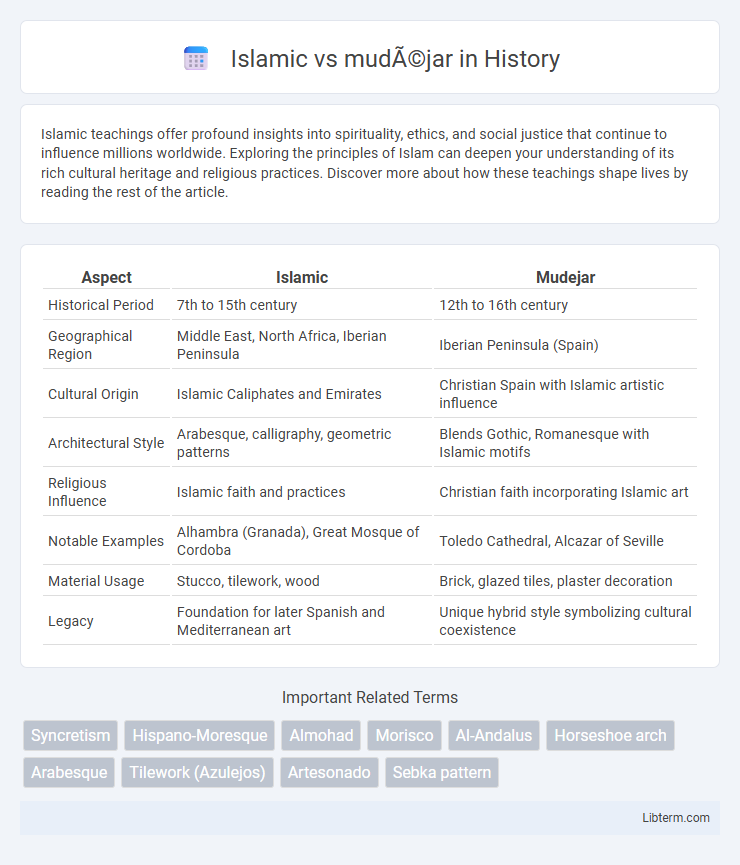Islamic teachings offer profound insights into spirituality, ethics, and social justice that continue to influence millions worldwide. Exploring the principles of Islam can deepen your understanding of its rich cultural heritage and religious practices. Discover more about how these teachings shape lives by reading the rest of the article.
Table of Comparison
| Aspect | Islamic | Mudejar |
|---|---|---|
| Historical Period | 7th to 15th century | 12th to 16th century |
| Geographical Region | Middle East, North Africa, Iberian Peninsula | Iberian Peninsula (Spain) |
| Cultural Origin | Islamic Caliphates and Emirates | Christian Spain with Islamic artistic influence |
| Architectural Style | Arabesque, calligraphy, geometric patterns | Blends Gothic, Romanesque with Islamic motifs |
| Religious Influence | Islamic faith and practices | Christian faith incorporating Islamic art |
| Notable Examples | Alhambra (Granada), Great Mosque of Cordoba | Toledo Cathedral, Alcazar of Seville |
| Material Usage | Stucco, tilework, wood | Brick, glazed tiles, plaster decoration |
| Legacy | Foundation for later Spanish and Mediterranean art | Unique hybrid style symbolizing cultural coexistence |
Introduction to Islamic and Mudéjar Architecture
Islamic architecture, characterized by intricate geometric patterns, horseshoe arches, and expansive courtyards, reflects the religious and cultural values of Muslim societies from the 7th century onward. Mudejar architecture, emerging in the Iberian Peninsula after the Reconquista, represents a unique fusion where Islamic ornamental techniques and motifs are integrated into Christian building forms. Both styles emphasize elaborate tilework, wood carving, and stucco decoration, showcasing a blend of cultural influences that shaped medieval architectural heritage in Spain.
Historical Origins and Influences
Islamic architecture in Spain originated during the Umayyad Caliphate's expansion in the 8th century, featuring intricate arabesques, horseshoe arches, and geometric patterns that symbolized Islamic spirituality. Mudejar style emerged after the Christian Reconquista, blending Islamic artistic techniques with Christian architectural forms from the 12th to 16th centuries, showcasing wooden ceilings, tilework, and brickwork influenced by Muslim artisans. Both styles reflect cultural interchanges on the Iberian Peninsula, illustrating the coexistence and adaptation of Islamic motifs within Christian contexts.
Key Architectural Features of Islamic Style
Islamic architecture is characterized by intricate geometric patterns, arabesques, and calligraphy that adorn walls and ceilings, emphasizing aniconism and spiritual symbolism. Key features include pointed arches, muqarnas (stalactite vaulting), large courtyards with fountains, and expansive domes designed to create a sense of harmony and tranquility. The extensive use of tilework, horseshoe arches, and elaborate stucco decoration distinguishes Islamic style from the Mudejar, which blends Islamic influences with Christian architectural elements.
Distinctive Elements of Mudéjar Design
Mudejar design uniquely blends Islamic artistic elements with Christian architectural styles, characterized by intricate geometric patterns, horseshoe arches, and elaborate tilework known as azulejos. Its distinctive use of brick and woodwork creates ornamental facades and ceilings that emphasize symmetry and detailed craftsmanship. This style reflects the cultural coexistence in medieval Spain, preserving Islamic aesthetics within Christian contexts.
Materials and Construction Techniques
Islamic architecture extensively uses intricate stucco, glazed tiles, and carved wood combined with horseshoe arches and ribbed domes, emphasizing geometric and vegetal motifs created through precise craftsmanship. Mudejar construction integrates Christian structural forms with Islamic decorative materials such as brick, terracotta, and ceramic tiles, resulting in ornamental patterns and wooden coffered ceilings (artesonados) that showcase craftsmanship adaptability. The use of brick in Mudejar architecture not only serves structural purposes but also acts as a decorative element, contrasting with the predominantly stone and plaster materials favored in Islamic buildings.
Decorative Motifs and Symbolism
Islamic decorative motifs in architecture emphasize intricate geometric patterns, arabesques, and calligraphy reflecting religious themes and the infinite nature of Allah. Mudejar art, developed in medieval Spain, integrates Islamic motifs with Christian symbols, featuring stylized vegetal patterns, interlacing designs, and tilework known as azulejos that blend cultural symbolism. Both styles use repetitive, rhythmic ornamentation to convey spirituality, yet Mudejar incorporates more figurative Christian iconography alongside traditional Islamic abstraction.
Regional Variations and Adaptations
Islamic architecture in Spain, exemplified by the Alhambra in Granada, features intricate geometric patterns and arabesques that vary regionally based on local materials and cultural influences. The Mudejar style, emerging after the Reconquista, blends Islamic decorative elements with Christian architectural forms, adapting regional vernacular techniques such as brickwork and tile mosaics especially prominent in Aragon and Castilla-La Mancha. These adaptations highlight a synthesis that respects traditional Islamic art while integrating Christian symbolism unique to each area's historical context.
Notable Examples of Islamic and Mudéjar Buildings
The Alhambra in Granada stands as a quintessential example of Islamic architecture, showcasing intricate stucco work, geometric patterns, and lush gardens that epitomize Nasrid artistry. In contrast, the Mudejar style, blending Islamic motifs with Christian architecture, is exemplified by the Torre del Oro in Seville, featuring distinctive brickwork and ornamental tile designs. Both styles highlight Spain's historical interweaving of cultures, with Islamic buildings emphasizing elaborate decorative arts and Mudejar constructions reflecting the synthesis of Christian structural forms and Islamic aesthetic elements.
Cultural and Religious Significance
Islamic art and architecture emphasize intricate geometric patterns, calligraphy, and aniconism, reflecting the religious principles of Islam and the cultural value placed on unity and divine creation. Mudejar style, emerging in medieval Spain, blends Islamic artistic motifs with Christian architectural elements, symbolizing a unique cultural coexistence and religious syncretism during the Reconquista. The Mudejar style serves as a historical testament to the interplay between Muslim, Christian, and sometimes Jewish communities, preserving Islamic aesthetics within a predominantly Christian framework.
Legacy and Modern Impact
The Islamic architectural legacy is marked by intricate geometric patterns, arabesques, and the use of water elements, which profoundly influenced the Mudejar style that blends Islamic artistic principles with Christian motifs. Mudejar architecture, prominent in medieval Spain, preserves this heritage through distinctive brickwork, ornamental tilework, and horseshoe arches, bridging cultures in a visually rich dialogue. Today, both styles inspire contemporary design, particularly in decorative arts, urban landscaping, and restoration projects, reflecting a sustained cultural and historical impact on modern aesthetics and architectural innovation.
Islamic Infographic

 libterm.com
libterm.com